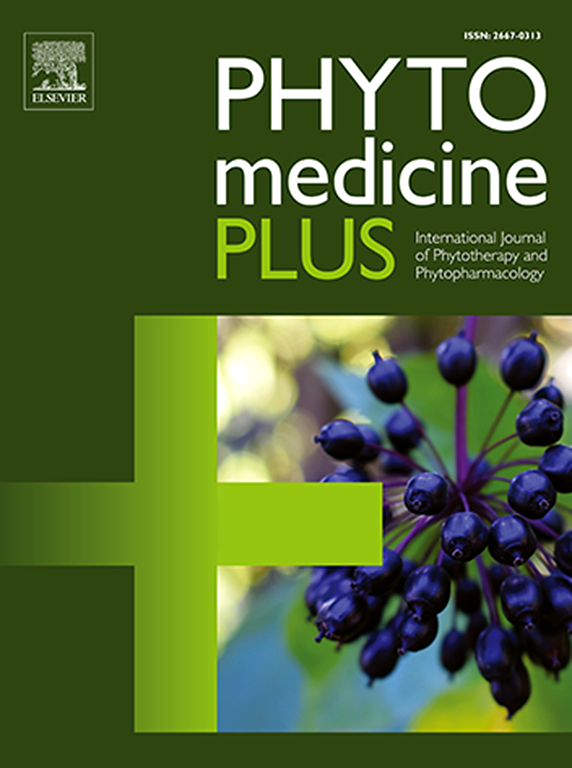芦笋水甲醇提取物的利尿作用。小鼠叶片及其溶剂组分
Q3 Pharmacology, Toxicology and Pharmaceutics
引用次数: 0
摘要
背景尼泊尔芦笋的叶子。传统上用于治疗尿潴留和作为利尿剂,但科学验证是有限的。目的采用标准化的实验模型,评价尼泊尔香叶提取物及其溶剂组分的利尿作用。方法遮荫干燥,粉碎成粗粉,80%甲醇冷浸浓缩。取一部分粗提物,用极性递增的溶剂:正己烷、乙酸乙酯和水进行分馏。将小鼠分为阴性对照组(给予2%的吐温80或蒸馏水)、阳性对照组(给予10 mg/kg的呋塞米)和实验组,分别以100、200、400 mg/kg的剂量口服80%甲醇提取物或其溶剂部分。然后在给药后1、2、3、4、5小时测量尿量。同时,从每只动物身上取尿样进行电解质分析和pH测量。最后将治疗组的平均值与阴性对照组的平均值进行比较。结果80%甲醇提取物、乙酸乙酯部位和水部位在200和400 mg/kg剂量下具有显著的利尿作用,尿量较阴性对照组显著增加(p <;0.001)。在这些剂量下,这些组分也表现出显著的尿钠和尿钾作用(p <;0.001),进一步证实了它们的利尿作用。此外,粗提取物的最高剂量(p <;0.01),乙酸乙酯部分(p <;0.001),水馏分(p <;0.001)显著提高了尿液pH值。结论尼泊尔龙骨叶水甲醇提取物及其乙酸乙酯和水馏分具有利尿作用。所观察到的利尿作用可能归因于不同次级代谢物的存在。然而,这项工作缺乏使用先进的分析技术和机制研究的提取物和馏分的化学表征。这些局限性可能会在未来的其他研究中得到解决。尽管存在这些局限性,但本研究为尼泊尔芦叶的传统治疗应用提供了科学验证,为进一步研究尼泊尔芦叶的化学成分和药理特性奠定了基础。本文章由计算机程序翻译,如有差异,请以英文原文为准。

Diuretic effects of hydromethanolic extract of Rumex nepalensis Spreng. leaves and its solvent fractions in mice
Background
The leaves of Rumex nepalensis Spreng. have been traditionally utilized for treating urinary retention and as a diuretic, but scientific validation is limited.
Purpose of the study
This study aimed to evaluate the diuretic activity of R. nepalensis leaf extract and solvent fractions using standardized experimental models.
Methods
The leaves of the plant were dried under shade, crushed to a coarse powder, and subjected to cold maceration with 80% methanol and concentrated. A portion of the crude extract was taken and fractionated using solvents of increasing polarity: n-hexane, ethyl acetate, and water. The mice were divided into different groups, including negative control groups (received 2% tween 80 or distilled water), positive control groups (given 10 mg/kg of furosemide), and experimental groups receiving the 80% methanol extract or its solvent fractions at doses of 100, 200, and 400 mg/kg orally. Then urine volume was measured at 1st, 2nd, 3rd, 4th, and 5th hours post-dosing of the treatments. Meanwhile, a urine sample was taken from each animal for electrolyte analysis and pH measurement. The mean values of the treatment groups were finally compared against those of the negative controls.
Results
The results showed that the 80% methanol extract, ethyl acetate fraction, and aqueous fraction at doses of 200 and 400 mg/kg produced significant diuretic effects, marked by substantial increases in urine volume compared to the negative control (p < 0.001). The fractions also demonstrated significant natriuresis and kaliuresis effect at these doses (p < 0.001), further confirming their diuretic efficacy. Additionally, the highest doses of the crude extract (p < 0.01), ethyl acetate fraction (p < 0.001), and aqueous fraction (p < 0.001) significantly increased the pH of the urine.
Conclusion
This investigation demonstrated the diuretic effect of the hydromethanolic extract of R. nepalensis leaves and its ethyl acetate and aqueous fractions. The observed diuretic effect is possibly attributable to the presence of different secondary metabolites. However, this work lacks chemical characterization of the extract and the fractions using advanced analytical techniques and mechanistic studies. These limitations may be addressed by other studies in the future. Despite these limitations, the current study has offered a scientific verification for the traditional therapeutic application of R. nepalensis leaves and this may serve as a foundation for future research on the chemical composition and pharmacological properties of the plant.
求助全文
通过发布文献求助,成功后即可免费获取论文全文。
去求助
来源期刊

Phytomedicine Plus
Medicine-Complementary and Alternative Medicine
CiteScore
3.70
自引率
0.00%
发文量
178
审稿时长
81 days
期刊介绍:
 求助内容:
求助内容: 应助结果提醒方式:
应助结果提醒方式:


